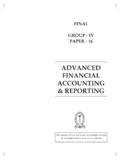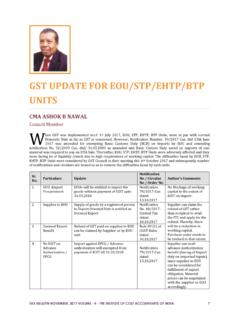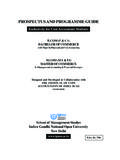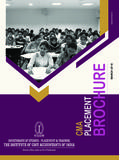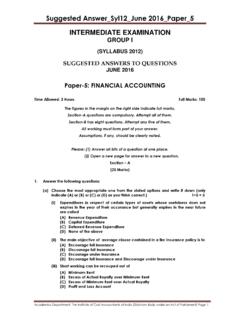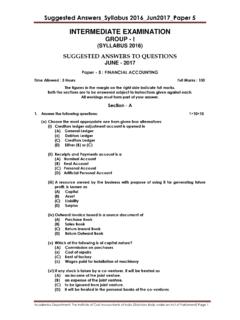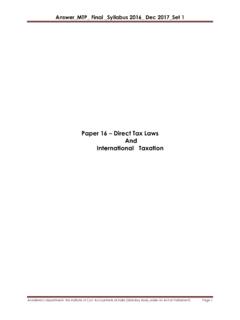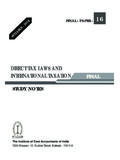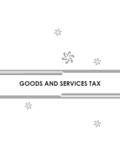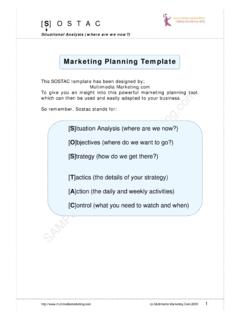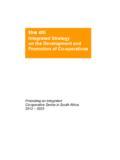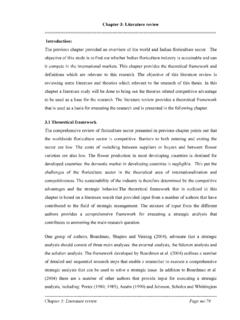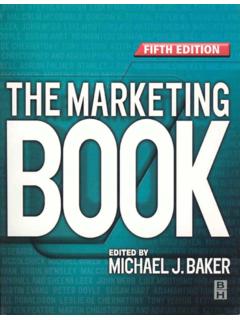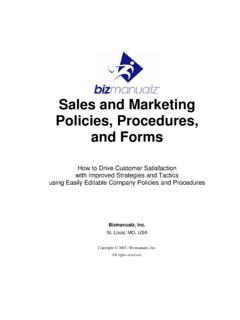Transcription of opERATIoNs MANAgEMENT & sTRATEgIc …
1 INTERMEDIATE : pApER -9 INTERMEDIATEsTuDy NoTEsopERATIoNs MANAgEMENT & sTRATEgIc MANAgEMENTThe Institute of cost Accountants of IndiaCMA Bhawan, 12, Sudder Street, Kolkata - 700 016syllAbus - 2016 First Edition : August 2016 Reprint : January 2018 Published by :Directorate of StudiesThe Institute of Cost Accountants of India (ICAI)CMA Bhawan, 12, Sudder Street, Kolkata - 700 at :Jayant Printery LLP352/54, Girgaum Road,Murlidhar Temple Compound,Mumbai - 400 of these Study Notes is reserved by the Institute of Cost Accountants of India and prior permission from the Institute is necessary for reproduction of the whole or any part 9: opERATIoNs MANAgEMENT & sTRATEgIc MANAgEMENT (OMSM)Syllabus StructureThe syllabus comprises the following topics and study weightage:AOperations MANAgEMENT 70%BStrategic Management30%B30%A70%ASSESSMENT STRATEGYT here will be written examination paper of three provide an in depth study of the various business process, analyze opERATIoNs , production planning and sTRATEgIc AimsThe syllabus aims to test the student s ability to: Understand the business process and analyze the opERATIoNs Acquire knowledge of production planning and resource MANAgEMENT Understand the concept of Corporate Vision - Mission and Objectives Understand the concept of SWOT and Portfolio analysis Understand the different stages in strategy formulation process Understand the concept of sTRATEgIc Business Unit and Business Process re-enginneringSkill Set requiredLevel B: Requiring the skill levels of knowledge, comprehension, application and A : opERATIoNs Management70%1.
2 opERATIoNs MANAgEMENT Introduction2. opERATIoNs Planning 3. Designing of Operational Systems and control 4. Production Planning and control5. Productivity MANAgEMENT and quality management6. Project Management7. Economics of Maintenance and Spares managementSection B : sTRATEgIc Management30%8. sTRATEgIc MANAgEMENT Introduction9. sTRATEgIc analysis and sTRATEgIc Planning 10. Formulation and Implementation of Strategy Syllabus - 2016sEcTIoN A: opERATIoNs MANAgEMENT [70 MARks]1. operation MANAgEMENT Introduction: Scope characteristics of modern opERATIoNs functions - recent trends in production / opERATIoNs opERATIoNs planning: Demand forecasting capacity planning - capacity requirement planning - facility location - facility layout Resource aggregate planning Material requirements planning Manufacturing resource planning Economic Batch Designing of operational systems and control: Product Design, Process design - Selection - Product Life Cycle Process Planning Process production planning and control.
3 Introduction Control Measures Time study, Work study, Method study, Job Evaluation, Job Allocation (Assignment Technique), Scheduling Queuing Models, Simulation and Line Balancing Optimum Allocation of resources Lean opERATIoNs JIT Transportation Model and Linear Programming Technique (Formulation of equations only).5. productivity MANAgEMENT and Quality MANAgEMENT : Measurement techniques of productivity index, productivity of employee, productivity of materials, productivity of MANAgEMENT resources, productivity of other factors productivity improving methods TQM basic tools and certification ISO standards project MANAgEMENT : Project planning project life cycle Gantt charts, PERT and Economics of Maintenance and spares MANAgEMENT : Break down Maintenance Preventive Maintenance Routine Maintenance Replacement of Machine Spare Parts b: sTRATEgIc Manangement [30 marks]8.
4 sTRATEgIc MANAgEMENT Introduction Vision- Mission and objective9. sTRATEgIc analysis and sTRATEgIc planning situational analysis SWOT analysis Portfolio analysis BCG Matrices Stages in sTRATEgIc Planning Alternatives in sTRATEgIc Planning10. Formulation and Implementation of strategy: Strategy formulation function wise (Production Strategy, Marketing Strategy, Man Power Strategy) Structuring of Organisation for implementation of strategy sTRATEgIc Business Unit Business Process Note 1 : operation MANAgEMENT opERATIoNs MANAgEMENT - Introduction Production MANAgEMENT vs. Operation MANAgEMENT Characteristic of Modern Operation Function Recent Trends in Production / opERATIoNs MANAgEMENT 4study Note 2 : opERATIoNs Demand Forecasting Capacity Planning Capacity Requirement Facility Location Facility Layout Resource Aggregate Planning Material Requirements Planning Manufacturing Resource Planning Enterprise Resource Planning Economic Batch Quantity 38study Note 3 : Designing of operational system and Production Design Process Design & Selection Process Planning Product Life Cycle Process Selection 51study Note 4.
5 Production planning and Production Planning and Control Introduction Time Study, Work Study, Method Study & Job Evaluation Job Allocation Assignment Technique Scheduling Queuing Models Simulation Line Balancing Lean opERATIoNs Just-In-Time (JIT) Transportation Model Linear Programming Technique 114study Note 5 : productivity MANAgEMENT and Quality Measurement Techniques of Productivity Index TQM Basic Tools and Certification ISO Standard Basics 147study Note 6 : project Project Planning Gantt Charts PERT and CPM 160study Note 7 : Economics of Maintenance and spares Break Down Maintenance Preventive Maintenance Routine Maintenance Replacement of Machine Spare Parts MANAgEMENT 181study Note 8 : sTRATEgIc MANAgEMENT Vission, Mission and Objective 209study Note 9 : sTRATEgIc analysis and sTRATEgIc situational analysis SWOT analysis Portfolio analysis BCG Matrices Stages in sTRATEgIc Planning Alternative in sTRATEgIc Planning 238study Note 10 : Formulation and Implementation of Strategy Formulation Function-wise (Production Strategy, Marketing Strategy, 241 Manpower Strategy Structuring of Organisation for Implementation of Strategy sTRATEgIc Business Unit Business Process Re-engineering 260operations managment & sTRATEgIc MANAgEMENT 1 This Study Note opERATIoNs MANAgEMENT - Production MANAgEMENT vs.)
6 Operation Characteristic of Modern Operation Recent Trends in Production/ opERATIoNs ManagementStudy Note - 1 opERATIoNs MANAgEMENT opERATIoNs MANAgEMENT - INTROduCTION opERATIoNs MANAgEMENT is the MANAgEMENT of that part of an organization that is responsible for producing goods and/or services. there are examples of these goods and services all around you. every book you read, every video you watch, every e-mail you send, every telephone conversation you have, and every medical treatment you receive involves the opERATIoNs function of one or more organizations. so does everything you wear, eat, travel in, sit on, and access the internet , in order to have a clear idea of opERATIoNs MANAgEMENT , one must have an idea of operating systems .an Operating System is defined as a configuration of resources combined for the provision of goods or organizations, hospitals, bus and taxi services, tailors, hotels and dentists are all examples of operating systems.
7 Any operating system converts inputs, using physical resources, to create outputs, the function of which is to satisfy customers wants. the creation of goods or services involves transforming or converting inputs into outputs. Various inputs such as capital, labour, and information are used to create goods or services using one or more transformation processes ( , storing, transporting, and cutting). to ensure that the desired output are obtained, an organization takes measurements at various points in the transformation process (feedback) and then compares with them with previously established standards to determine whether corrective action is needed (control).it is important to note that goods and services often occur jointly. For example, having the oil changed in your car is a service, but the oil that is delivered is a good.
8 Similarly, house painting is a service, but the paint is a good. the goods-service combination is a continuum. it can range from primarily goods, with little service, to primarily service, with few goods. Because there are relatively few pure goods or pure services, companies usually sell product packages, which are a combination of goods and services. there are elements of both goods production and service delivery in these product packages. this makes managing opERATIoNs more interesting, and also more OF opERATIoNs MaNageMeNTobjectives of opERATIoNs MANAgEMENT can be categorised into (i) customer service and (ii) resource utilisation.(i) Customer serviceThe first objective is the customer service for the satisfaction of customer wants. Customer service is therefore a key objective of opERATIoNs opERATIoNs MANAgEMENT must provide something to a specification which can satisfy the customer in terms cost and timing.
9 Thus, primary objective can be satisfied by providing the right thing at the right price at the right time .These three aspects of customer service - specification, cost and timing - are described in a little more detail for the four functions in Table 1. they are the principal sources of customer satisfaction and must, therefore, be the principal dimension of the customer service objective for operation MANAgEMENT Introduction2 opERATIoNs managment & sTRATEgIc managementTable 1: aspects of Customer ServicePrincipal customer wantsPrincipal functionPrimary considerationOther considerationmanufacturegoods of a given, requested or acceptable specificationcost purchase price or cost of obtaining goodstiming, delivery delay from order or request to receipt of goodstransportmovement of a given, requested or acceptable specificationcost, cost of movement, timing , (i) duration or time to move(ii) wait, or delay from requesting to its commencementsupplygoods of a given, requested or acceptable specificationcost, that is purchase price or cost obtaining goodstiming, delivery delay from order or request to supply, to receipt of goodsservicetreatment of a given, requested or acceptable specificationcost, cost of treatmenttiming, (i)
10 Duration or timing required for treatment(ii) wait, or delay from requesting to its commencementgenerally an organization will aim reliably and consistently to achieve certain standards, or levels, on these dimensions, and opERATIoNs managers will be influential in attempting to achieve these , this objective will influence the opERATIoNs manager s decisions to achieve the required customer service.(ii) Resource utilizationanother major objective is to utilize resources for the satisfaction of customer wants effectively, , customer service must be provided with the achievement of effective opERATIoNs through efficient use of resources. Inefficient use of resources or inadequate customer service leads to commercial failure of an operating MANAgEMENT is concerned essentially with the utilization of resources, , obtaining maximum effect from resources or minimizing their loss, under utilization or waste.
